15th Attack Squadron
15th Attack Squadron is a United States Air Force unit assigned to the 432d Wing at Creech Air Force Base near Indian Springs, Nevada. It flies General Atomics MQ-9 Reaper Unmanned aerial vehicles.
| 15th Attack Squadron | |
|---|---|
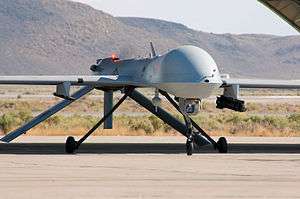 MQ-1B Predator of the 15th Attack Squadron | |
| Active | 1917–1919; 1921–1927; 1928–1946; 1947–1949; 1951–1990; 1991–1994; 1997–present |
| Country | |
| Branch | |
| Role | unmanned aerial vehicle strike |
| Size | over 140 personnel |
| Part of | Air Combat Command |
| Garrison/HQ | Creech Air Force Base |
| Nickname(s) | Cottonpickers (c. 1956-c. 1989)[note 1] |
| Motto(s) | Bellator Spectarendum Latin Watching Warrior |
| Mascot(s) | carrier pigeon |
| Equipment | MQ-1 Predator |
| Battle honours | Antisubmarine European Theater of Operations Korean War Global War on Terror (Expeditionary)[1] |
| Commanders | |
| Current commander | Lieutenant Colonel Robert E. Kiebler |
| First Sergeant | SMSgt Steve Flatt |
| Notable commanders | General Arthur J. Lichte Lieutenant General Paul Selva Brigadier General Michelle D. Johnson |
| Insignia | |
| 15th Attack Squadron emblem (approved 9 March 2017)[1] | 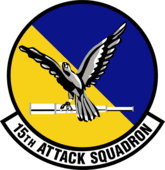 |
| 15th Tactical Reconnaissance Squadron emblem[note 2] | 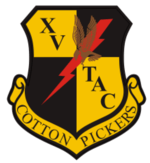 |
| 15th Observation Squadron emblem (approved 2 April 1924)[2][note 3][note 4] |  |
The 15th Attack Squadron is one of the first armed remotely piloted aircraft squadrons.[1] The squadron provides combatant commanders with persistent intelligence, surveillance and reconnaissance, full-motion video, and precision weapons employment. Global operations support continuous MQ-1B Predator employment providing real-time actionable intelligence, strike, interdiction, close air support, and special missions to deployed war fighters.
Mission
The 15th Attack Squadron is currently in operation at Creech Air Force Base, Nevada, and is the second of the Air Force's RQ-1 Predator unmanned aerial vehicle squadrons.
The mission of the squadron is to provide theater commanders with deployable, long endurance, near real-time reconnaissance, surveillance and target acquisition to close the sensor-to-shooter time line. The squadron operates medium altitude multi-sensor platforms to locate, identify and report battlefield conditions to warfighters. It also collects, exploits and distributes imagery and intelligence products to theater CINCs and national-level leadership.
History
World War I
The 15th Attack Squadron's origins go back to 8 May 1917, when it stood up as the 2d Aviation School Squadron at Hazelhurst Field, Long Island, New York. A little more than three months later, the squadron became the 15th Aero Squadron.[1] The original mission of the squadron was part of the defense force for the New York City area, flying coastal patrols and as a flying training unit. The squadron was demobilized at Hazwlhurst on 18 September 1919,[1] after the end of World War I.
Interwar years
The 15th Squadron (Observation) was organized in the Army Air Service on 21 September 1921 at Chanute Field, Illinois, and equipped primarily with Dayton-Wright DH-4s. the main focus of the squadron was flying training, including gunnery, observation, reconnaissance, photography, radio familiarization and similar missions. The squadron served as the air component of the 6th Division. In April 1924 the squadron, now the 15th Observation Squadron was consolidated with its World War I predecessor. The squadron moved to Kelly Field, Texas in June 1927, where on 1 August, it was inactivated[1] and its personnel and equipment used to form the 39th School Squadron.[3]
The squadron reformed at Selfridge Field, Michigan on 15 March 1928, once again providing air support for the 6th Division.[1] On 20 March 1938, the 15th Observation Squadron deployed from Scott Field, Illinois, to Eglin Field, Florida, for two weeks of gunnery training. Thirty-five officers and 108 enlisted men were involved.[4]
World War II
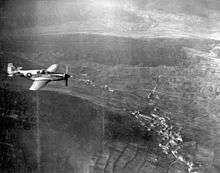
During the early stages of World War II, the 15th supported the Field Artillery School in Oklahoma. On 26 March 1944, the unit deployed to England and began combat operations over France. Its first combat mission was photographic reconnaissance on a North American F-6 Mustang. On 6 June 1944, the 15th received credit for the first aerial victory by a tactical reconnaissance pilot as well as the first victory of D-Day. The unit continued armed reconnaissance operations in the European theater until July 1945. After returning to the United States, the squadron provided visual and photographic reconnaissance and artillery adjustments for Army, Navy and Air Forces until it was inactivated in April 1949.[1]
Korean War

The 15th Tactical Reconnaissance Squadron, Photo-jet, was reactivated on 5 February 1951, in Japan and immediately deployed to Korea to provide visual and photographic reconnaissance. The unit flew Lockheed F-80 Shooting Stars North American F-86 Sabres and the RF-80 and RF-86 reconnaissance versions of these fighters during this period.[1]
Pacific reconnaissance
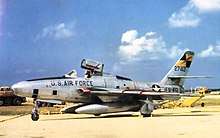
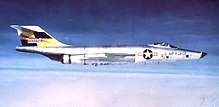
In March 1954 the unit moved back to Japan and in August 1956, moved to Okinawa. The unit transitioned to Republic RF-84F Thunderflashes from 1956-1958 and then to McDonnell RF-101 Voodoos, continuing its long history of photographic reconnaissance. During the Vietnam era the 15th Squadron was based at Kadena Air Base, Okinawa, flying the RF-101C. The unit had many deployments to Southeast Asia, flying reconnaissance missions in support of US combat operations in that theatre. During the summer and fall of 1966, the squadron transitioned to the McDonnell RF-4C Phantom II, the aircraft that it was to operate for the next 25 years. Redesignated as 15 Tactical Reconnaissance Squadron on 8 Oct 1966.[1]

In January 1968 the squadron deployed from Kadena to Osan Air Base, Korea in support of Operation Combat Fox, flying reconnaissance missions over North Korea during the Pueblo Crisis under extremely harsh winter conditions that disabled many of the squadron's aircraft, reducing squadron strength to as low as six aircraft at one point. One aircraft was lost on mission during this period. A second aircraft was lost in an accident after the squadron moved to Itazuke Air Base, Japan.
During the 1970s and 1980s, the squadron maintained aerial surveillance capabilities in support of American ground, naval and air forces in the Far East. The 15th Squadron was inactivated 1 October 1990.[1]
Intelligence activities
The unit was reactivated as the 15th Tactical Intelligence Squadron on 20 February 1991. On 13 April 1992, the unit was redesignated as the 15th Air Intelligence Squadron. On 1 June 1994, it was once more inactivated.[1]
Unmanned aerial vehicle operations
The unit was reactivated as the 15th Reconnaissance Squadron on 1 August 1997, at Indian Springs Air Force Auxiliary Field under the 57th Operations Group. It was assigned to fly the General Atomics MQ-1 Predator unmanned aerial vehicle from Indian Springs.[1]
From July 2005 to June 2006, the 15th Squadron participated in more than 242 separate raids; engaged 132 troops in contact-force protection actions; fired 59 Hellfire missiles; surveyed 18,490 targets; escorted four convoys; and flew 2,073 sorties for more than 33,833 flying hours.[5]
Starting in 2005, the unit trained California Air National Guard's 163d Reconnaissance Wing members to operate the MQ-1. The 163d is being retasked as an MQ-1 unit. In May 2016, the squadron was redesignated the 15th Attack Squadron.[1] The MQ-1 Predator was retired from United States Air Force service on 9 March 2018.[6]
Lineage
- 15th Aero Squadron
- Organized as the 2d Aviation School Squadron on 9 May 1917
- Redesignated 15th Aero Squadron on 22 August 1917
- Demobilized on 18 September 1919
- Reconstituted, and consolidated with the 15th Observation Squadron as the 15th Observation Squadron on 8 April 1924[1]
- 15th Attack Squadron
- Authorized as the 15th Squadron (Observation) on 30 August 1921
- Organized on 21 September 1921
- Redesignated 15th Observation Squadron on 25 January 1923
- Consolidated with the 15th Aero Squadron on 8 April 1924
- Inactivated on 1 August 1927
- Activated on 15 May 1928
- Redesignated 15th Observation Squadron (Medium) on 13 January 1942
- Redesignated 15th Observation Squadron on 4 July 1942
- Redesignated 15th Reconnaissance Squadron (Fighter) on 2 April 1943
- Redesignated 15th Tactical Reconnaissance Squadron on 11 August 1943
- Inactivated on 31 March 1946
- Activated on 3 December 1947
- Inactivated on 1 April 1949
- Redesignated 15th Tactical Reconnaissance Squadron, Photo-Jet on 5 February 1951
- Activated on 25 February 1951
- Redesignated 15th Tactical Reconnaissance Squadron on 8 October 1966
- Inactivated on 1 October 1990
- Redesignated 15th Tactical Intelligence Squadron on 20 February 1991
- Activated on 15 March 1991
- Redesignated 15th Air Intelligence Squadron on 13 April 1992
- Inactivated on 1 June 1994
- Redesignated 15th Reconnaissance Squadron on 31 July 1997
- Activated on 1 August 1997
- Redesignated 15th Attack Squadron on 15 May 2016[1]
Assignments
- Unknown, 1917–1919[note 9]
- Sixth Corps Area, 21 September 1921
- 6th Division Air Service, 24 March 1923 (attached to Sixth Corps Area)
- Sixth Corps Area, June–1 August 1927
- 6th Division Air Service (later 6 Division Aviation), 15 May 1928 (attached to Sixth Corps Area)
- 14th Observation Group, 8 May 1929 (attached to Sixth Corps Area)
- 12th Observation Group, 17 July 1937[7] (attached to Sixth Corps Area)[note 10]
- Detachment operated at Field Artillery School, 1 December 1940
- Field Artillery School, c. 9 Jan 1941
- III Air Support Command, 1 September 1941 (attached to Field Artillery School, further attached to 68th Observation Group, 12 December 1941 – 2 February 1942)
- 73d Observation Group (later 73d Reconnaissance Group, 73d Tactical Reconnaissance Group, 10th Photographic Group), 12 March 1942 (attached to Field Artillery School until 1 April 1942)
- Ninth Air Force, 22 December 1943 (attached to 67th Tactical Reconnaissance Group)
- IX Fighter Command, 30 Dec 1943 (attached to 67th Tactical Reconnaissance Group)
- 67th Tactical Reconnaissance Group, 4 January 1944 (attached to IX Air Support Command (later IX Tactical Air Command)[note 11] until c. 16 March 1944)
- 10th Photographic Group (later 10th Reconnaissance Group), 13 June 1944 (attached to IX Tactical Air Command until 27 June 1944)
- Flight attached to 67th Tactical Reconnaissance Group, 3–12 August 1944
- United States Strategic Air Forces in Europe, 24 June 1945
- Third Air Force, 3 August 1945
- First Air Force, 3 February 1946
- Tactical Air Command, 21–31 March 1946
- 10th Reconnaissance Group (later 10th Tactical Reconnaissance Group), 3 December 1947 – 1 April 1949 (attached to 363d Reconnaissance Group, 22 August – 3 November 1948)
- 67th Tactical Reconnaissance Group, 25 Feb 1951 (aAttached to 67th Tactical Reconnaissance Wing, 1 June–c. 25 November 1954 and after 1 July 1957)
- 67th Tactical Reconnaissance Wing, 1 October 1957 (attached to 18th Tactical Fighter Wing after 15 March 1960)
- 313th Air Division, 25 April 1960 (attached to 18th Tactical Fighter Wing until 20 April 1970)
- 18th Tactical Fighter Group, 1 May 1978
- 18th Tactical Fighter Wing, 11 February 1981
- 460th Tactical Reconnaissance Group, 1 October 1989 – 1 October 1990
- 548th Reconnaissance Technical Group, 15 March 1991
- Pacific Air Forces, 3 July 1991
- 15th Operations Group, 13 April 1992 – 1 June 1994
- 57th Operations Group, 1 August 1997
- 432d Operations Group, 1 May 2007 – present[8]
Stations
|
|
Aircraft
- Curtiss JN-4, apparently 1917–1919, 1921–1927.
- Curtiss JN-6, apparently 1917–1919, 1921–1927.
- Dayton-Wright DH-4, apparently 1917–1919, 1921–1927.
- Douglas O-2, 1921–1927, 1928–1930
- Curtiss JNS-1, 1921–1927
- Apparently M-1, 1921–1927
- Thomas-Morse O-19, 1930-c. 1938
- Douglas O-46, 1936-c. 1939
- North American O-47, 1939–1942,
- Douglas O-43, during part of the period 1939-1942
- Stinson O-49 Vigilant, during part of the period 1939-1942
- Curtiss O-52 Owl, during part of the period 1939-1942
- Douglas A-20 Havoc, 1942–1943
- Bell P-39 Airacobra, 1942–1943
- Curtiss P-40 Warhawk, 1942–1943
- North American P-51 Mustang, 1942–1943, 1947–1948
- Supermarine Spitfire, 1943-1944
- Piper L-4 Grasshopper, 1943–1944
- Stinson L-5 Sentinel, 1943–1944
- North American F-6 (later RF-51) Mustang, 1944–1945, 1947–1949
- Lockheed RF-80 Shooting Star, 1951–1956
- North American RF-86 Sabre, 1951–1956
- Lockheed F-80 Shooting Star, 1952–1953
- North American F-86Sabre, 1953
- Republic RF-84F Thunderflash, 1956–1958
- McDonnell RF-101 Voodoo, 1958–1966
- McDonnell RF-4C Phantom II, 1967–1990
- General Atomics RQ-1 Predator, 1997–present
- General Atomics MQ-1 Predator, 1997–present[1]
Honors
Campaign Streamers
- World War II: Europe-Africa-middle Eastern (EAME) Theater: Air Offensive, Europe; Normandy; Northern France; Rhineland Ardenees-Alsace; Central Europe; Air Combat.
- Korean War: First UN Counteroffensive; CCF Spring Offensive; UN Summer-Fall Offensive; Second Korean Winter; Korea Summer-Fall, 1952; Third Korean Winter; Korea Summer-Fall, 1953.
Decorations
- Distinguished Unit Citations: Korea, 25 February – 21 April 1951; Korea, 9 July – 27 November 1951; Korea, 1 May – 27 July 1953.
- Cite in Order of the Day, Belgian Army: 6 June- [25 June] 1944.
- Republic of Korea Presidential Unit Citation: [25] February 1951 – 31 March 1953.
- Republic of Vietnam Gallantry Cross with Palm: 1 April – 30 November 1966.
- Air Force Outstanding Unit Awards: 1 December 1952 – 3 April 1953; 10 May −27 August 1962; 1 September 1962 – 31 August 1963; 1 August 1964 – 5 June 1965; 6 June 1965 – 31 December 1966; 1 January 1968 – 31 December 1969; 1 January 1974 – 31 December 1975; 1 June 1977 – 31 May 1979; 1 October 1979 – 31 May 1980; 1 July 1981 – 31 May 1983; 1 June 1983 – 31 May 1984; 1 June 1984 – 31 May 1986; 1 June 1987 – 31 May 1989; 1 October 1989 – 30 October 1990; 13 April 1992 – 30 June 1993.
See also
- List of American Aero Squadrons
References
Notes
- Explanatory notes
- This nickname derived from WWII instances of squadron's aircraft returning with shrubbery in the wings from flying low-level reconnaissance missions.
- Shield quartered in yellow and black, eagle riding a red lightning bolt descending from right to left, XV in upper left yellow quarter, TAC in lower left yellow quarter, scroll below with Cottonpickers. Used while on Okinawa. Apparently the squadron also wore a patch shortly after in converted to the RF-80 depicting a tiger riding a jet plane with a camera for its nose and a bullet narrowly missing the plane. This was not official, however. See Maurer, Combat Squadrons, p. 87 (1924 emblem still official in 1963).
- A carrier pigeon in natural colors with wings extended perched on a telescope white outlined in black upon a shield of blue and yellow parted diagonally from "northwest" to "southeast", the blue above, the yellow below. Maurer, p. 87
- The 15th Observation Squadron also had a Disney Studios designed emblem with a bee on a cloud peering through binoculars and seated on a camera, while taking notes, all in front of the number 15. It was not official. See Maurer, Combat Squadrons, p. 87 (1924 emblem still official in 1963).
- Aircraft is North American RF-86A-5-NA Sabre serial 48–195 at K-14 Airfield, South Korea, 1952.
- Aircraft is Republic RF-84F-30-RE Thunderflash, serial 52-7412, taken in 1956.
- Aircraft is RF-101 Voodoo, serial 56-42, taken in 1960.
- Aircraft is McDonnell RF-4C-19-MC Phantom II, serial 63-7751 at Kadena AB, Okinawa in 1975.
- Possibly Aeronautical Division (later Air Division), Signal Corps, 9 May 1917; Training Section, Department of Military Aeronautics, Signal Corps, 24 April 1918; Operations Section, Department of Military Aeronautics, Signal Corps, 9 July 1918; Training and Operations Group, Air Service, 29 January – 18 September 1919. Dollman.
- Dollman just says July 1937. However, Clay also indicates the 12th Group was inactivated on 1 July 1937. Clay, p.1306.
- Dollman says "later XIX Air Support Command." However, XIX Air Support Command was a different unit. Maurer, Combat Units, pp. 451-452. This attachment is omitted in Maurer, Combat Squadrons, p. 86
- Citations
- Dollman, TSG David (18 October 2016). "Factsheet 15 Attack Squadron (ACC)". Air Force Historical Research Agency. Retrieved 25 July 2017.
- Maurer, Combat Squadrons, pp. 85-87
- See Maurer, Combat Squadrons, p. 333 (activation of 39th School Squadron)
- Crestview, Florida, "Plenty of Activity at Val-P Gun Base", Okaloosa News-Journal, Crestview, Florida, Friday 18 March 1938, Volume 24, Number 12, page 1.
- Staff Sgt. D. Clare, "California Air National Guard embraces new mission", 16 August 2006 Archived 18 October 2006 at the Wayback Machine
- "Sun setting the MQ-1 Predator: The final salute". Retrieved 24 March 2020.
- Clay, p. 1383
- Assignments in Dollman, except as noted.
- Station number in Anderson.
- Station number in Johnson.
- Station information in Dollman, except as noted.
Bibliography
![]()
- Anderson, Capt. Barry (1985). Army Air Forces Stations: A Guide to the Stations Where U.S. Army Air Forces Personnel Served in the United Kingdom During World War II (PDF). Maxwell AFB, AL yes: Research Division, USAF Historical Research Center. Archived from the original (PDF) on 23 January 2016. Retrieved 28 June 2017.
- Clay, Steven E. (2011). US Army Order of Battle 1919-1941 (PDF). Vol. 3 The Services: Air Service, Engineers, and Special Troops 1919-1941. Fort Leavenworth, KS: Combat Studies Institute Press. ISBN 978-0-98419-014-0. LCCN 2010022326. OCLC 637712205. Archived from the original (PDF) on 27 September 2013. Retrieved 16 October 2012.
- Johnson, 1st Lt. David C. (1988). U.S. Army Air Forces Continental Airfields (ETO) D-Day to V-E Day (PDF). Maxwell AFB, AL: Research Division, USAF Historical Research Center. Archived from the original (PDF) on 29 September 2015. Retrieved 26 June 2017.
- Maurer, Maurer, ed. (1983) [1961]. Air Force Combat Units of World War II (PDF) (reprint ed.). Washington, DC: Office of Air Force History. ISBN 0-912799-02-1. LCCN 61060979. Retrieved 17 December 2016.
- Maurer, Maurer, ed. (1982) [1969]. Combat Squadrons of the Air Force, World War II (PDF) (reprint ed.). Washington, DC: Office of Air Force History. ISBN 0-405-12194-6. LCCN 70605402. OCLC 72556. Retrieved 17 December 2016.
- Ravenstein, Charles A. (1984). Air Force Combat Wings, Lineage & Honors Histories 1947-1977. Washington, DC: Office of Air Force History. ISBN 0-912799-12-9. Retrieved 17 December 2016.